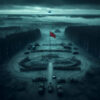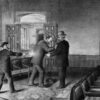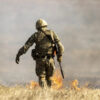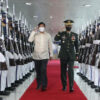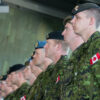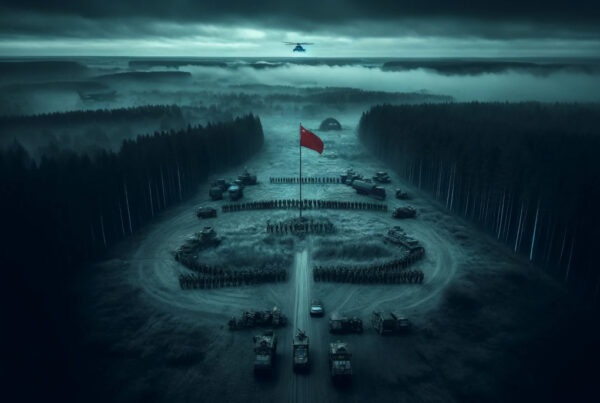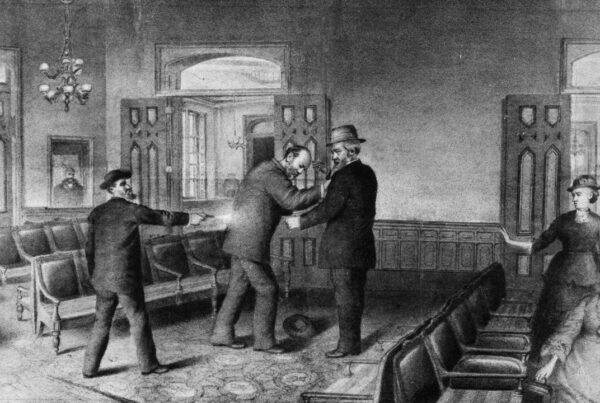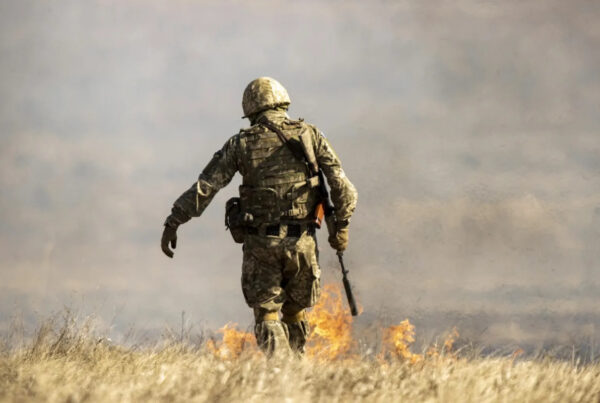There remains much confusion and ambiguity about Russia among the political elite of most western countries. They still do not quite realize that the Russian Federation is not a nation-state like most of Europe’s larger countries. Russia is an Empire as it always has been.
Its citizens’ sense of self, their sense of pride and belonging is tied to a mythology of imperial grandeur, expansion and plunder. It was at one time the home of 85 distinct languages and dialects. Many have since disappeared. Where a nation-state is like an organ, an empire is a tumor. It exists to expand and it consumes as it expands. It continues this process provided it has a steady and sufficient blood supply. In the case of today’s Russian Federation that blood supply is the revenue it collects on its sale of oil and natural gas.
It was Winston Churchill who once famously described Russia saying, “I cannot forecast to you the action of Russia. It is a riddle, wrapped in a mystery, inside an enigma; but perhaps there is a key. That key is Russian national interest.” [1] It is worth noting that Winston’s predecessor of the previous century, Benjamin Disraeli, suffered no such confusion. Back in 1876, Prime Minister Benjamin Disraeli – in a letter to Queen Victoria, proposed “to clear Central Asia of Muscovites and drive them into the Caspian.” [2] He did not call them Russians. He knew his opponents for who they were. Even though the Czars demanded, ever since the early 18th century, that their empire be renamed as the Rossian Empire, politicians and cartographers alike continued to use the historical term Muscovy. A look at today’s Russian Federation shows it to be, despite a series of regime changes and name changes, a geographical and political continuation or agglomeration of that multiethnic empire that Batu Khan, grandson of Genghis, had created. For five hundred years that empire was known as Muscovy. It was even referred to as Tartary. This heritage bore little respect among the aristocratic circles of 17th century Europe. And so after gaining full control over the lands of the actual historic Rus’, the Ukrainian lands around Kyiv in 1721, Czar Peter the Great renamed his Czardom of Muscovy as the Rossian Empire from the word Rossia, the Greek name for Rus’. This was a transparent attempt to appropriate the legacy of ancient Rus’. Similarly the legend of the “Third Rome” was also employed to gain traction among Europe’s elite. Today however, the land and the people of the actual Rus’ are again outside the borders of this empire.
Strange as it may seem, much of the political elite of this empire still feels a phantom limb pain for this missing land. Certainly the reassembling of the Rossian Empire has been an oft-stated goal of Vladimir Putin. It was on 24 April 2005 that Putin told his country that the collapse of the Soviet empire “was the greatest geopolitical catastrophe of the century”. [3] He left no doubt that he intended to right that wrong. [4]
Even as the USSR was collapsing, the time bombs and landmines that would help in future efforts to reassemble it were being laid. These were the “frozen conflicts” of Transdnistria, South Ossetia, Abkhazia, and Nagorno-Karabakh; and the direct basing of Russian forces on the territory of nominally independent states, such as Ukraine, Tajikistan or Armenia. This put Russian forces in place to simplify the messy problem of actual invasion when the time came. It can be argued that the nuclear disarmament of Ukraine under the guarantee of the Budapest Memorandum was just another such careful preparation for the reassembling of empire.
Vladimir Putin took it upon himself to collect the wayward colonies of the empire. First he centralized state power at home via his construction of a “vertical of power”, and protected it by “managed democracy”. Then he solved his own “frozen conflict” in Chechnya by allowing Chechen to fight against Chechen rather than involving his own GRU troops. After the Beslan siege was winding down, Putin found that he needed to turn his attention to Ukraine. A pro-Western presidential candidate was leading in the polls. I will not detail here the Kremlin’s meddling in that election. The end result was the Orange Revolution in Ukraine and the coming to power of the pro-Western Victor Yushchenko. Putin knew he had to quickly rein in this wayward satellite.
Just as Maxim Litvinov, the Soviet Commissar of Foreign Affairs declared in 1933 that “Food is a weapon.” [5] Vladimir Putin realized that with respect to Rus’-Ukraine, Natural Gas could also be a weapon. It was on 1 Jan 2006 that he first cut off gas from Ukraine. The effectiveness of this was hampered by the fact that such actions affected Western Europe too, and thus the inflow of revenue to Gazprom/Russia. For the natural gas weapon to work he had to isolate Ukraine. To do that he had to build bypass pipelines around Ukraine.
The first Ukraine bypass pipeline was Nord Stream laid along the bottom of the Baltic Sea all the way to Germany. Putin even had former Chancellor of Germany, Gerhard Schroder, agree to be chairman of the project. [6] [7] The second pipeline project is South Stream, a pipeline that would transport natural gas from the Yamal deposit by the Arctic Sea, south to the east shore of the Black Sea, then under the sea bypassing Ukrainian territorial waters, to Varna in Bulgaria. This project, which is far from complete, is now estimated to cost $77B. This expenditure is on top of the vanity expenditure of $50B for the Sochi Winter Olympics. It should be noted that since Ukraine’s existing pipeline system is more than adequate for any projected European requirements,these are expenses that will not generate a single dollar of additional revenue. They are purely political projects that cannot be justified by either economics or common sense. It is not surprising that Russia is now sliding into a recession. [8]
But what has derailed the Putin plan completely is his underestimation of the shale gas revolution. Laughably, as recently as 2010 Gazprom was anticipating supplying LNG to the US; [9] what totally destroyed the plan was the discovery of shale gas in Ukraine. [10] [11] Ukraine is facing a future of natural gas self-sufficiency, if not that of a net supplier. This calculation explains why, although the EU Association Agreement overtures of a pro-Western, democratic reform President Yushchenko were rejected in November 2005; [12] the autocratic boorish thug of a President, Yanukovych presiding over a country that was broke, was enthusiastically invited to the EU table in the summer of 2013. It more than explains the panicked reaction of Putin when he realized that Russia’s influence over Ukraine would vanish, as would all hopes of its reincorporation into the empire. The pressure Putin put on President Yanukovych was relentless and by some reports, physically personal. Eventually the Yanukovych regime relented and accepted a loan promise from Russia in place of signing the Association Agreement with the European Union.
For another 10 weeks, despite all the protest activity on the Maidan, Kyiv’s city square, Putin was satisfied that Ukraine was still in Russia’s orbit. Then late on 21 February 2014 Yanukovych abandoned his post. He went AWOL and eventually showed up in Russia. Within days he was formally impeached by the Ukrainian Verkhovna Rada (Parliament) and a search warrant was issued. As the curtain closed on the Sochi Winter Olympics on 23 February, Putin realised that he had bet the farm on his bypass pipelines, and lost. Ukraine was going to align herself with Western Europe and wean herself off Russian gas. Like the gambler in a Hollywood Western that realizes that he overplayed his hand, Vladimir Putin kicked over the card table and drew his gun. As the last visitors to the Olympics were filing through the airport gates, the Russian military began to roll its APC’s beyond the confines of their Sevastopol base to begin the occupation of Ukraine’s Crimean peninsula.
Russia’s military occupation of Ukraine’s Crimean peninsula:
It was 26 February 2014 that Russian military vehicles were seen on Crimean roads. Roadblocks were being set up by the Russian military, presumed to be from the existing multiple bases of the Black Sea Fleet. Thousands of ethnic Russian demonstrators protesting the change of government in Kyiv clashed with Crimean Tatars who supported the democratic revolution. Ethnic Russians were forming so-called “Self-Defence” units. In Russia’s Western region on the northern borders of Ukraine, Putin ordered massive military exercises of air and ground forces. [13] Despite that, very few western pundits were informed enough to have predicted the Russian invasion that commenced the very next day. [14]
On 27 February about 150 unidentified soldiers and four Kamaz heavy trucks arrived at the Simferopol Airport. A small crowd of about 25 civilians stood nearby holding a flag of the Russian Black Sea Fleet. No explanation of their presence was forthcoming. [15] At the Simferopol Verkhovna Rada (Parliament) about 120 heavily armed men stormed the building, occupying it. [16] While it was occupied by the gunmen, the Verkhovna Rada of Crimea dismissed the current presidium and installed a new Chairman of the Council, Sergey Aksyonov, aka “Goblin”, a leader of the Russian Unity party and a known gangster and racketeer. [17] They also voted to hold a referendum on expanding the rights of the Autonomy of Crimea on 25 May 2014. Since then, on 6 March 2014, this was changed to a referendum on joining the Russian Federation with the vote reset to 16 March 2014.
That same day two large assault vessels (invasion landing ships), the Kaliningrad and the Minsk of Russia’s Baltic fleet, were observed passing through the Bosphorus. [18] That day, the Ukrainian flagship, the frigate Hetman Sahaidachnyy, just completed the joint anti-piracy exercises “EU Navfor Atalanta” with the EU in the Aegean Sea. [19] It was then to return to Ukraine.
On 28 February 2014, Russian helicopters were seen heading to Belbek, the Sebastopol airport. That same day thirteen enormous Russian IL76 transport aircraft were reported to have landed at this Sevastopol airport. [20] Five more were reported to have landed at Gvardiysky airport near Simferopol. Ten BTR’s (APCs) were also seen, heading in the direction of the capital of Crimea, Simferopol. In Belbek all air traffic was halted. About 400 individuals had blocked that airport runway. A flight of ten helicopters was reported to be flying in from the Kerch peninsula in the east. [21]
By 2 March 2014 Russian soldiers had occupied most of Crimea. Estimates ranged up to 30,000 troops on the ground. It is noteworthy that all of them were equipped with the very latest gear and equipment, but they wore neither insignia nor any identifying markings. That day the Ukrainian garrison in Kerch was surrounded by Russian troops. The ferries that run across the Kerch Straits had also been seized for use by the Russian military. Among such passengers over the next days would be an entire Russian biker gang.
It is noteworthy that the Ukrainian military adopted the tactic of passive resistance with no firearms. They often faced armed Russians nose to nose but were not giving up their bases. One can speculate that this was intentionally a complete reversal of the tactics that had been employed by Mikheil Saakashvili’s Georgian forces in August 2008. Georgia’s small armed forces resisted the Russian invasion immediately, vigorously and with notable early success. As events of this Crimean war unfold, this Ukrainian tactic may be either praised or criticised, but the immediate effect was a propaganda victory and a palpable frustration in the ranks of the enemy.
Another defeat of Putin’s propaganda was the immediate discrediting of a staged Ukrainian terrorist attack on suitable “victims”. Reporters caught the arrival of these visiting “terrorists” on locally licensed buses, including one tour bus from the local zoo and noted that they were armed with the latest Russian arms. [22] The “victims” had no visible traces of blood. Journalists later collected spent cartridges and reported that they were clearly blanks. [23] A video was used by Putin to ask his Parliament to authorise the introduction of Russian forces into Crimea, days after they were already there.
On 3 March, as US administration officials were reporting that the Russians had total control of Crimea, German Chancellor Angela Merkel told President Obama that she felt that Putin had lost touch with reality and was in another world. [24] That same day the US carrier President George HW Bush with a fleet of 17 warships approached the Black Sea placing Crimea within range of its aircraft. No further developments came from this.
On 5 March 2014 the guided missile cruiser Truxton was reported sailing through the Bosphorus. Inside Crimea, special envoy Robert Serry of the Secretary General of the UN was prevented from completing his duties by unidentified armed men in uniform. They stopped his car and held him virtually hostage in a coffee shop. Later he was allowed to go directly to the airport in Simferopol to leave Crimea. That same day the representative of the OSCE on matters of freedom of speech, Dunia Miatovych, had been blockaded in her hotel, the hotel Ukrayina, by men in camouflage and body armour. She was finally able to leave the building and fly back to Kyiv. She had been meeting with editors of the local media and community activists. [25]
That day, a company of the Ukrainian Army, the Dnipropetrovsk Paratrooper Company who was in Crimea for training along with the 36th Coast Guard Marines were asked to disarm by the invading Russian forces. The Ukrainian side refused, explaining they had enough ammunition to hold off a siege. And once the ammunition ran out, they explained, they would blow up their light armour along with themselves and the enemy, taking to guerilla tactics. [26]
During the night of 5-6 March in Donuzlav Bay, the Russians attempted to block the entrance into the harbour by sinking two of their own ships, the Ochakiv and the rescue tug Shakhtar, [27] to trap the vessels of the Ukrainian Navy stationed there.
For the next few days Russian activity was limited to the blockading of all Ukrainian military bases and harassment of Ukrainian military personnel. On 10 March, near the village of Chongar in the Kherson oblast’ (province) just north of the Crimean border, a Crimean Berkut road block stopped an Avtomaidan motorcade carrying mail and humanitarian aid to blockaded Ukrainian soldiers. The riot police opened fire, wounding one man from Zaporizha in the chest. [28]
The Security Service of Ukraine reported that early in the morning on 12 March a group of Russian “spies” had been intercepted by Ukraine’s SBU (Sluzhba Bezpeky Ukrayiny, Security Service). The group was reconnoitring the 208th brigade of surface to air defences along with the 79th mobile brigade around Kakhovka in the Kherson oblast. Kakhovka is the location of the hydro power station that supplies all the electricity to Crimea. The leader of the group was an officer of Russia’s GRU, born in 1981 in the Ryazan Oblast of the Russian Federation, but using the Ukrainian passport of a Yevhen Arbuzov born 1986. [29] That same day, news media reported the build up of Russian armour on the northeast border of Ukraine, barely 50km north of Kharkiv, [30]Ukraine’s second largest city.
The preparation of a causus belli in eastern Ukraine began 13 March with a violent clash between pro-Russian and pro-Ukrainian demonstrators in the city of Donetsk. This resulted in possibly the first fatality of the Ukrainian-Russian conflict. The clash resulted in three wounded and one dead. [31] [32] It was later reported that many of the demonstrators were Russian citizens. Similar events occurred in Kharkiv [33] and other eastern cities the next day.
13 March was also the day that the acting Prime Minister of Ukraine, Arseniy Yatseniuk, met with President Barak Obama in Washington DC, who, despite assurances and platitudes, refused to ship arms to Ukraine. [34] This lack of tangible military aid was especially troubling in light of the fact that it was Senator Obama, along with Senator Lugar, that in 2005 convinced then Ukrainian President Yushchenko to scrap 400,000 small arms and 1000 surface to air missiles. [35] These weapons, that had been left over from Soviet times, were now sorely needed by the newly recruited National Guard that was being formed to reinforce Ukraine’s existing army.
On 15 March Russian airborne troops landed their helicopters near the village of Strilkove in the Kherson oblast’ and seized the gas distribution station that supplies Crimea with natural gas. [36] This was noted by Sen. John McCain who was in Kyiv that day ahead of the Crimean referendum; part of a bipartisan group of US senators. Sen. McCain called for military assistance to Ukraine as the right and decent thing for America to do. [37] Canada’s Foreign Affairs Minister John Baird announced that Prime Minister Steven Harper would travel to Kyiv for meetings with Prime Minister Arseniy Yatseniuk on 22 March, making Harper the first G7 leader to do so during this crisis. [38]
On 16 March 2014 Crimeans voted in the Referendum that offered two Yes choices, and no “No” choice.
The choices were:
1. Are you in favor of the reunification of Crimea with Russia as a part of the Russian Federation?
2. Are you in favor of restoring the 1992 Constitution and the status of Crimea as a part of Ukraine? [39]
A return to the 1992 Constitution — adopted after the Soviet collapse but quickly thrown out by post-Soviet Ukraine – effectively provided for Crimea’s independence, while remaining part of Ukraine.
The reported results were 97% for option 1 (96% in Sebastopol) [40] with a voter turnout of 83% (89% in Sebastopol). On 18 March Russian President Putin announced that Russia would incorporate Crimea. As of the time this article is being written, this annexation has been recognized by only Armenia, Syria, Kazakhstan and Venezuela, and all Russian client states. Significantly China has not recognized the validity of the referendum. Quite notably, during the UN Security Council vote, China had abstained from voting. It is quite possible that it was positioning itself as the impartial arbiter in the hope of forming the UN peacekeeping force in Crimea if events ever lead to that. That would then be China’s first foray onto the European stage.
It is no secret that Russian control of Crimea terrifies the indigenous Crimean Tatar population. The Tatars had lived in Crimea for some 700 years. It was only after the Russo-Turkish war (1768-1764) that Russia gained control over Crimea, which it quickly annexed in 1783. [41] In 1944 Stalin deported the entire Tatar population of Crimea to Central Asia after regaining control of the peninsula from the retreating Germans. [42] Half of the deportees died en route. Tatars were not allowed to return to Crimea until the late 1980’s. The Tatar Mejlis (council), fearing a return of Russian brutality, had enthusiastically supported keeping Crimea as part of Ukraine. [43] Their worst fears were confirmed the next day. On 17 March the body of Reshat Ametov was found showing signs of torture. [44] Reshat had disappeared in Simferopol on 3 March.
The next day added more victims of Russian violence. One Ukrainian soldier was killed by a bullet through the heart and another officer was wounded during the storming by the Russians of a photogrammetric center in Simferopol. The Russians used snipers for this task and withheld medical help after the shooting. They arrested all Ukrainian military personnel at the station. [45]
Currently Crimea is an economic basket case. It depends entirely on Ukraine for its electrical power and its natural gas. Up to 80% of this desert peninsula’s water supply comes via canal from Ukraine. It is connected by road and rail only to Ukraine. There is only a ferry connection across the Kerch Straits to mainland Russia. These were, in fact, the reasons that Crimea was transferred to the Ukrainian SSR in 1954. These are also good implications that Russia cannot stop at Crimea, but will also make an attempt to take the neighboring Kherson oblast’ (province) just north of the peninsula.
However, the Black Sea shelf within Crimea’s territorial waters contains significant deposits of natural gas and oil. [46] Both Exxon and Shell are involved in the exploration and development of these resources. A further benefit of the Crimean annexation for Russia/Gazprom is the shorter, shallower and cheaper route across the Black Sea for the South Stream pipeline. [47] And so while the anticipated invasion of Ukraine may, in fact, be about historical mythology, the conquest of Crimea is not about history, nor people, nor even language. The conquest of Crimea is about hydrocarbons.
Implications of Russia’s military occupation and annexation of Ukraine’s Crimean peninsula:
In 1994 Ukraine possessed the world’s third largest nuclear arsenal. Under pressure from US President Clinton and Russia’s President Yeltsin, Ukraine signed an agreement to divest itself of all its nuclear weapons. In exchange for that action, Russia, the UK and the USA undertook to respect Ukraine’s borders in accordance with the principles of the 1975 CSCE Final Act, to abstain from the use or threat of force against Ukraine, to support Ukraine where an attempt is made to place pressure on it by economic coercion, and to bring any incident of aggression by a nuclear power before the UN Security Council. [48] This agreement is usually referred to as the Budapest Memorandum. As with many such agreements, this agreement is legally binding, but not enforceable.
What must be asked is what are the implications of not guaranteeing Ukraine’s territorial integrity militarily.
The implication to Ukraine is self-evident: the loss of Crimea, its territorial waters, the oil and gas reserves of the Black Sea shelf, the freedom of the Kerch Strait and of a domestic Cote d’Azure vacationing spot. Offsetting that is the decrease by two million of the population of Russo-phones that have always represented, if not necessarily a fifth column, then surely an Achilles heel with respect to Ukraine’s eastern neighbour. A less obvious benefit will be a more sober view by Ukrainians of their eastern neighbour and of any of their own citizens that refuse to learn the country’s official language.
The implications to Crimea are somewhat sadder. Among them are no electricity, much less fresh water, loss of tourism, loss of agricultural capacity, conflict with a Crimean Tatar insurgency, and the oppressive boot of a militaristic imperial regime.
The benefits to Russia are many, including additional gas and oil reserves for Gazprom, a safer, cheaper and shorter route for the South Stream pipeline, expanded basing capacity for the Black Sea Fleet, an additional two million Russian Orthodox, Russian-speaking citizens and an overall dominance of the Black Sea. Offsetting this will be a fresh insurgency by a Muslim minority, likely supported by both Turkey and Ukraine.
But it is the implications for the rest of the world that are most worrying. The relative peace in this world has been a result of interconnected treaties, agreements and yes, memorandums. What this peace didn’t need today is the realization that the words of agreements are worth less than the paper they are written on. Nuclear disarmament and nuclear non-proliferation will be reversed. [49] Easily a dozen non-nuclear-armed countries will have to reconsider that position. Certainly among them will be Japan, South Korea, Taiwan, Iran, Egypt, Poland, Ukraine, [50] the Baltic states, Finland, and yes, Canada.
Resource-rich, under-populated Canada may prove to be the most vulnerable of all. It could be said that the refusal to build a pipeline has be seen as an unfair trade barrier by some distant energy hungry land. Or, given the opening of the North West Passage, would the sudden appearance of 10,000 armed men without insignia on say Ellesmere or Baffin Island prove to be a fait accompli? [51] In the end, enforcing the unenforceable may prove to be less costly than the alternative.
If Putin’s imperial adventure ends up being limited to the Crimean peninsula, there may be one more sanction that could be applied. Today the world has come to understand the concept of “conflict diamonds” and the penalties applied to their sale. It may be appropriate to coin the concept of “conquest hydrocarbons”. The entire volume of extracted hydrocarbon resources from this conquered territory will be deemed to be included in the exported hydrocarbon stream. A penalty tax of 100% of the wholesale export price including transit cost would be applied to this volume, payable on a pro rata basis by the various importing countries/entities. Suitable penalties for under-reporting and audit procedures would be applicable to companies extracting these hydrocarbon resources. The money so collected would be paid to the victim country’s state treasury as compensation.

